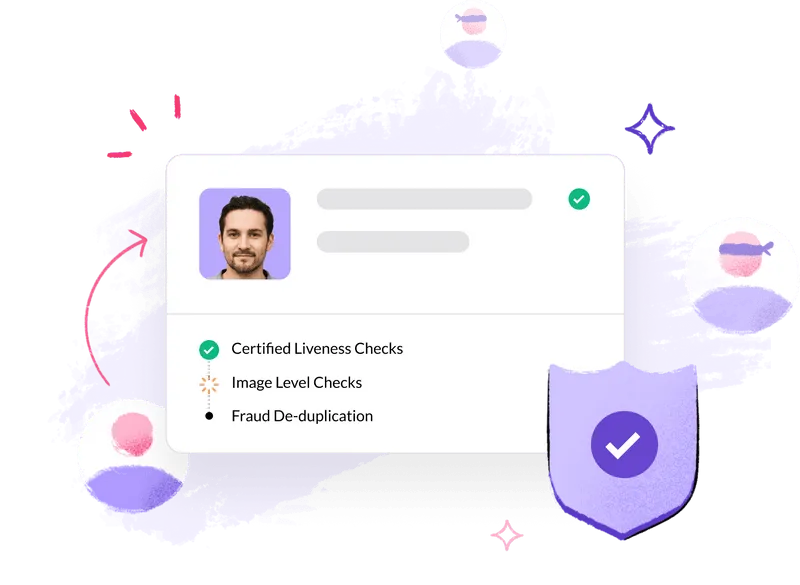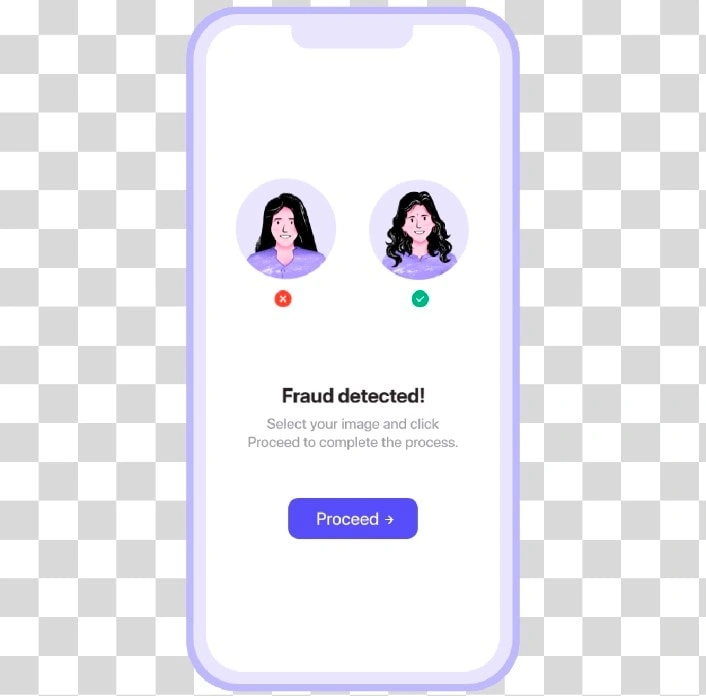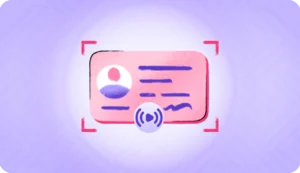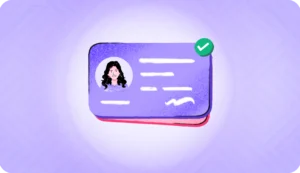As we spend more of our lives online, the threat of identity theft has become a pressing concern. Fraudsters are getting smarter with exploiting gaps in identity verification. They’re finding new ways to bypass traditional security checks. Staying ahead of these evolving threats is crucial. Businesses need advanced security measures that can prevent fraud.
Enter document liveness detection. This game-changing technology adds an extra layer of protection by authenticating documents. It can differentiate between real and fraudulent IDs. Thus making it a crucial tool for secure remote identity verification. In this article, we’ll explore what document liveness detection is. We’ll detail how it works, and why it’s essential in today’s digital landscape.
What is document liveness detection?
Online transactions and remote interactions are the norm in today’s digital landscape. Hence, the role of liveness detection has become very important. It adds an extra layer of security, protecting businesses and individuals from fraud.
Defining document liveness detection
Document liveness detection is a cutting-edge security technique. It checks if a live person is presenting an identity document in real time. An identity document can span from a passport or a driver’s license to house permits. It avoids static images or pre-recorded videos. It ensures that the documents are both genuine and in active use by their rightful owners.
The need for robust document verification
The traditional identity verification process includes manual review or simple ID photo analysis. They have proven inadequate in combating the sophisticated techniques employed by modern fraudsters. These outdated methods often rely on static images or copies of documents. These can be subject to manipulation or duplication. Cybercriminals exploit these weaknesses to create fake identities or steal personal information.
The rise of document fraud highlights the need for more robust verification methods. Those that can detect and prevent fraudulent activities with ease. This is where document liveness detection comes into play. It adds a dynamic element to the verification process. This ensures the documents are authentic and with their rightful owner. This makes it much harder for fraudsters to succeed. Since they would need to overcome the extra hurdle of proving liveness.
Understanding the verification process
The identity verification process is complex. Each step ensures that the individual’s identity is legitimate. They also confirm that their documents are authentic.
Identity verification: A multi-step process
The process often begins with the submission of identity documents. They are then scrutinized to confirm their authenticity. Document verification is a key component of this process. Liveness detection confirms that a live user is presenting the ID. It ensures that there’s no use of a static digital image or video.
Types of identity documents
Verification processes use various types of identity documents. They include passports, driver’s licenses, national ID cards, and house permits. Government authorities issue these documents. They come with many security features to prevent tampering and counterfeiting. Some of the most common features include:
- Holograms: These are 3D images embedded in the document. They change their appearance when viewed from different angles.
- Watermarks: Invisible marks that become visible when the document is held up to the light.
- Microprints: Tiny text or images that are difficult to replicate without specialized equipment.
- UV Features: Elements that are only visible under ultraviolet light.
These security features are crucial in ensuring the authenticity of the document. Yet, even with these features, documents can still face manipulation or forgery. Especially when presented as static images. Liveness detection mitigates this risk.
How document liveness detection works
Several core principles form the basis of liveness detection. The technology behind it can differentiate between real and fake documents.
The science behind liveness detection
The primary goal is to confirm that the document is not a static photo or pre-recorded video. The system checks for the genuine document in the hands of a live person. This process involves analyzing various aspects of the document and its presentation. It includes movement, interaction with light, and response to specific stimuli.
This technology often incorporates advanced algorithms and machine learning models. This is because they can identify subtle differences between real and fake documents. For example, the system might analyze the light reflecting off the document’s surface. It may also check how the document reacts when moved or tilted. These subtle cues can reveal whether the document is genuine or a fraudulent copy.

Liveness detection techniques
This process employs several techniques. They address specific aspects of the ID verification process. Some of the most common techniques include:
- Image analysis: This involves evaluating the visual integrity of the document. It includes physical features, such as holograms, watermarks, and micro-prints. Image analysis can also involve checking for signs of tampering. Like, altered text or photo.
- Motion detection: These techniques track the natural movements of the document. They also track the person presenting it. To confirm that it is a live person, the user may need to tilt the document or move it in a specific pattern.
- Ultra violet (UV) light examination: Some liveness detection systems use UV light. It reveals hidden security features that are not visible under normal lighting conditions.
- Other advanced methods. Besides the above techniques, some systems incorporate machine learning and artificial intelligence. These advanced methods improve their accuracy and reliability. These systems can learn from new data and adapt to emerging fraud techniques. Thus making them more effective over time.
Document image analysis in-depth
Document image analysis is a critical component of liveness check. It involves extracting specific features from the document images to verify their authenticity. This process often involves several steps, including:
- Feature extraction: The system identifies and extracts key features from the document. These may include holograms, watermarks, and micro-prints. It then checks these features against the expected patterns for genuine documents.
- Machine learning: Machine learning algorithms analyze the extracted features. Then, they compare them against a database of known genuine documents. The system can identify subtle differences that might flag any tampering or forgery.
- Verification: The system verifies that the document is genuine. It also verifies that the document has not tampered with. If it detects any anomalies, the system may flag the document for further review.
- Real-time analysis: Liveness detection systems often perform these analyses in real-time. Thus allowing for immediate ID verification and reducing the risk of fraud.
Protect your business from fraud
with Hyperverge’s advanced document liveness solutions Schedule a DemoBenefits of document liveness detection
Unlike traditional verification processes, liveness detection technology comes with a host of benefits.
Enhanced security
One of the primary benefits is the enhanced security. Liveness detection significantly reduces the risk of document fraud and identity theft. It ensures that documents are in active use by their rightful user. This added layer of security is particularly important in industries handling sensitive information.
Liveness detection also helps prevent a wide range of fraud techniques, including:
- Spoof attacks: Where fraudsters use fake documents or images to impersonate someone else.
- Replay attacks: This refers to the use of pre-recorded videos or images. They bypass verification systems.
- Tampering: This means altering or manipulating non original documents to change their information.
By preventing these frauds, this detection helps maintain the integrity of verification processes. It also safeguards users’ personal information.

Improved customer experience
Document liveness detection boosts security and improves customers’ experience. This streamlines the onboarding process. Traditional ID verification methods can be time-consuming and cumbersome. They often need customers to wait for a manual review or provide extra documentation. Unlike that, liveness detection is faster and more convenient for users.
This improved efficiency also benefits businesses. By automating the verification process, organizations can quickly onboard new customers. This will lead to higher satisfaction rates and improved customer retention.
Compliance with regulations
Another key benefit is helping organizations follow regulatory requirements. They include Know Your Customer (KYC) and Anti-Money Laundering (AML) regulations. These regulations need businesses to verify the identities of their customers. They prevent fraud, money laundering, and other illegal activities.
Liveness detection ensures organizations obey compliance obligations while reducing the risk of fraud. By incorporating liveness detection, businesses can prove their commitment to security and compliance.
Challenges and future trends
Document liveness detection is a powerful tool for preventing fraud. Yet, it comes with certain challenges.
Overcoming liveness detection challenges
Several aspects like document quality can affect the accuracy of the liveness detection. Poor-quality images or damaged documents can hinder the verification process. Low lighting can also affect the system’s ability to verify a document’s authenticity.
Liveness detection technology is being adopted at a wide scale. To keep up, fraudsters are likely to develop new techniques to bypass these systems. Thus, liveness detection solutions must continuously evolve to stay ahead of emerging threats.
To overcome these, liveness detection systems are incorporating advanced technologies. For instance, artificial intelligence and machine learning. These technologies allow the systems to learn from new data. They also help them adapt to changing conditions. This, improving their accuracy and reliability over time.
The future of document liveness detection
Several emerging technologies are likely to shape the future of such detection. These include:
- Artificial intelligence (AI): AI-powered liveness detection systems can analyze vast amounts of data. This is key in identifying patterns and anomalies that lead to fraud. With future AI advancements, these systems will become even more accurate and efficient.
- Blockchain: This offers a decentralized, secure way to store and verify identity information. Integrating blockchain with liveness detection can create tamper-proof records of identity verification.
- Biometrics: This refers to technologies like facial recognition and fingerprint scanning. The use of biometrics with liveness detection keeps rising.
By keeping up with new technology, businesses can prevent identity fraud. This will help them and their customers.
Conclusion
Document liveness detection is revolutionizing the way we verify identities. It offers enhanced security, convenience, and real-time ID verification. With the rise of identity fraud, this technology is paramount. Liveness detection helps prevent fraud.
As technologies evolve, the importance of liveness detection in identity verification rises. This makes it an essential tool for preventing the ever-present threat of fraud.
Do you want to increase your business’ security? Book a demo with HyperVerge to learn how liveness detection can help.
FAQs
What is document liveness?
Document liveness is a security feature. It verifies that an identity document is being presented by a live user in real time. It ensures that the document is genuine. It also verifies that the document is in active use—rather than a static image or a pre-recorded video.
What is the liveness detection method?
Liveness detection methods involve using various techniques. Some of them are image analysis, motion detection, and UV light examination. These ensure that a document is authentic and presented by a real person. They do so by distinguishing real documents from fake or tampered ones.
What is liveness verification?
Liveness verification means confirming that the individual presenting the document is physically present. It also affirms that the document is genuine. This process is crucial in preventing identity fraud.





















